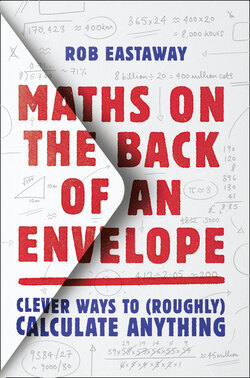Читать книгу Maths on the Back of an Envelope - Rob Eastaway - Страница 17
DOES THIS NUMBER MAKE SENSE?
ОглавлениеOne of the most important skills that back-of-envelope maths can give you is the ability to answer the question: ‘Does this number make sense?’ In this case, the back of the envelope and the calculator can operate in harmony: the calculator does the donkey work in producing a numerical answer, and the back of the envelope is used to check that the number makes logical sense, and wasn’t the result of, say, a slip of the finger and pressing the wrong button.
We are inundated with numbers all the time; in particular, financial calculations, offers, and statistics that are being used to influence our opinions or decisions. The assumption is that we will take these figures at face value, and to a large extent we have to. A politician arguing the case for closing a hospital isn’t going to pause while a journalist works through the numbers, though I would be pleased if more journalists were prepared to do this.
Often it is only after the event that the spurious nature of a statistic emerges.
In 2010, the Conservative Party were in opposition, and wanted to highlight social inequalities that had been created by the policies of the Labour government then in power. In a report called ‘Labour’s Two Nations’, they claimed that in Britain’s most deprived areas ‘54% of girls are likely to fall pregnant before the age of 18’. Perhaps this figure was allowed to slip through because the Conservative policy makers wanted it to be true: if half of the girls on these housing estates really were getting pregnant before leaving school, it painted what they felt was a shocking picture of social breakdown in inner-city Britain.
The truth turned out to be far less dramatic. Somebody had stuck the decimal point in the wrong place. Elsewhere in the report, the correct statistic was quoted, that 54.32 out of every 1,000 women aged 15 to 17 in the 10 most deprived areas had fallen pregnant. Fifty-four out of 1,000 is 5.4%, not 54%. Perhaps it was the spurious precision of the 54.32’ figure that had confused the report writers.
Other questionable numbers require a little more thought. The National Survey of Sexual Attitudes has been published every 10 years since 1990. It gives an overview of sexual behaviour across Britain.
One statistic that often draws attention when the report is published is the number of sexual partners that the average man and woman has had in their lifetime.
The figures in the first three reports were as follows:
| Average (mean) number of opposite-sex partners in lifetime (ages 16–44) | ||
| Men | Women | |
| 1990–91 | 8.6 | 3.7 |
| 1999–2001 | 12.6 | 6.5 |
| 2010–2012 | 11.7 | 7.7 |
The figures appear quite revealing, with a surge in the number of partners during the 1990s, while the early 2000s saw a slight decline for men and an increase for women.
But there is something odd about these numbers. When sexual activity happens between two opposite-sex people, the overall ‘tally’ for all men and women increases by one. Some people will be far more promiscuous than others, but across the whole population, it is an incontravertible fact of life that the total number of male partners for women will be the same as the number of women partners for men. In other words, the two averages ought to be the same.
There are ways you can attempt to explain the difference. For example, perhaps the survey is not truly representative – maybe there is a large group of men who have sex with a small group of women that are not covered in the survey.
However, there is a more likely explanation, which is that somebody is lying. The researchers are relying on individuals’ honesty – and memory – to get these statistics, with no way of checking if the numbers are right.
What appears to be happening is that either men are exaggerating, or women are understating, their experience. Possibly both. Or it might just be that the experience was more memorable for the men than for the women. But whatever the explanation, we have some authentic-looking numbers here that under scrutiny don’t add up.
